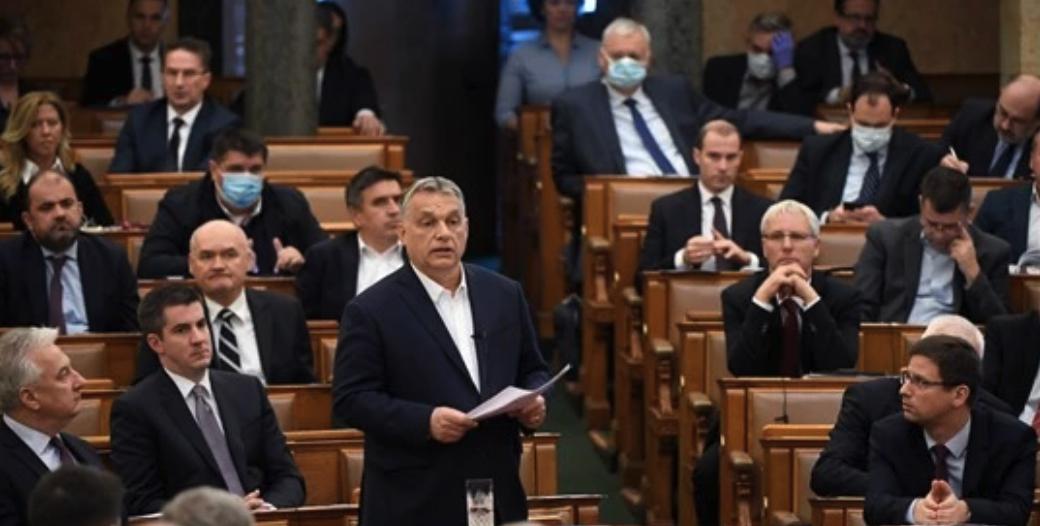Transnational Lineages of Authoritarianism: Hungary and Beyond
archive


Hungarian Prime Minister Viktor Orbán with Brazilian president Jair Bolaonaro and his wife Michelle in January 2019, at Bolsonaro's inauguration ceremony.
Transnational Lineages of Authoritarianism: Hungary and Beyond
In January 2019, Jair Bolsonaro, a far-right backbencher with more than twenty unremarkable years in the Brazilian Congress, was inaugurated as Brazil’s new head of state. Donald Trump and Hungarian President Viktor Orbán were some of the first to congratulate Bolsonaro on his victory. Although these three leaders may represent decidedly different countries and polities, they have bonded around their affinity for authoritarian practices and illiberal political behavior—all under the formal rubric of democratic government. Whereas Trump and Bolsonaro are newcomers to this phenomenon, Orbán’s de-democratization project in Hungary has been underway for a decade.1 The 2016 election of Trump to the U.S. presidency sent shockwaves the world over. Longstanding observers of right-wing politics put forth such explanations as rising inequality, creeping xenophobia, and cultural backlash against post-material values (gay marriage, abortion, climate change).2 However, we find these factors lacking when applied to the emerging economy context in which global dynamics of populist authoritarianism are playing out in countries like Brazil and Hungary. In this essay, we probe other possible contributing variables in the way of historical vestiges, authoritarian context, and institutional pushback, focusing mainly on the case of Hungary.
The Shadow of the Past
A rich literature on imperial and colonial legacies suggests that we cannot entirely rule out the effects of either.3 Despite the reign of a dual monarchy under the Austro-Hungarian Empire (1867-1918) and the numerous Central and Eastern European countries incorporated under this “multinational state” system, power was heavily concentrated and administrative duties centralized within the two monarchic poles of power. Soviet occupation of Hungary from 1945-1989 and the various iterations of socialism and communism during this period cemented a centralized pattern of governance that has continued into the post-Soviet era. A fierce nationalist, Orbán has further centralized politics, authority, and decision-making, allowing for his uninterrupted tenure as an “elected” president since 2010.
The Context for Authoritarian Populism
Hungary’s population is largely homogenous. Its per capita GDP is twice the size of Brazil’s, its Gini coefficient 25 points lower than that of Brazil (30 percent versus 55 percent),4 and Hungarian remittances account for some 3.4-4 percent of GDP. Hungary was hit especially hard by the 2008-09 global financial crisis and was the first European country to sign a standby loan and austerity package with the IMF.5
Orbán is the figurehead of a political party that espouses a populist authoritarian approach to governance, and faces no visible competition from within his party. He embraces a style of populism “that regards the elite and the people as two separate, antagonistic and homogenous groups…the people are pure and the elite are corrupt.”6 His political victory came in the wake of a disastrous political economic crisis, as he capitalized on the weak coalition of the Hungarian Socialist Party that governed from 2002-2010 and its incompetence in implementing IMF austerity measures in 2006 and 2008.
Institutional Pushback
The pushback of democratic institutions in the face of authoritarian populist infractions provides an accountability check in countries with populist governments where a broad commitment to democratic values has nevertheless held steady. We cannot say the same about Hungary. Orbán’s Fidesz party, working in coalition with the Christian Democrats and far-right Jobbik party, had locked down majority control of the National Assembly by 2010. The de-democratization project underway in Hungary is an insidious but sophisticated operation. Rather than bashing institutions of democratic accountability, Orbán and Fidesz have gradually woven an ideology of anti-globalism, nationalism, and illiberalism into the very fabric of the country’s institutions.
Orbán’s first tenure as president with the backing of Fidesz was from 1998-2002. As mentioned above, the economic failures of the democratic socialist coalition that ruled from 2002-2010 paved the way for Orbán’s return. By 2009, the post-1989 glow of liberal democratic capitalism had dimmed. Public opinion polls showed that only 56 percent of Hungarians approved of the country’s transition to a democratic regime, and just 46 percent approved of the shift to a capitalist economic model. In this same poll, 72 percent of respondents considered themselves worse off than under communism, versus 39 percent who held this view in the Czech Republic and 35 percent in Poland.
Rather than bashing institutions of democratic accountability, Orbán and Fidesz have gradually woven an ideology of anti-globalism, nationalism, and illiberalism into the very fabric of the country’s institutions.
Since 2010, Orbán has effectively spun a national narrative about the urgency of protecting Hungarian identity, traditions, and way of life. Fidesz and its coalition partners have instilled skepticism about EU cosmopolitanism and cast aspersions on western elites and their individualistic and secular ways of life. Simultaneously, this ruling coalition has attacked judicial independence and weakened the separation of powers. With Fidesz at the helm, the constitution was amended twelve times in twelve months and finally replaced altogether in 2012 “in a manner that eliminated nearly all opportunities for oversight.”7
This control at the constitutional level has made it exceedingly difficult for the political opposition to sustain accusations about the government’s abuse of power. After all, the “state” is now upholding its own warped but formal definition of constitutional democracy. In 2018, for example, the country’s standard 8th-grade history textbook was revised to contain new anti-refugee rhetoric, informing students that “it can be problematic for different cultures to co-exist.”8
While authoritarian populism has been an effective mobilization strategy in de-democratized Hungary, it requires continuous mobilization to sustain this mode of governance. The ruling coalition must identify new enemies of “pure Hungarians” on a rolling basis. Hence, the vitriol which Orbán and Fidesz have spewed toward nongovernmental organizations, independent media, and private universities. The European immigration crisis of 2015 was another boost for the sustenance of this defective democracy, as was the ousting of the Central European University founded by Hungarian-American billionaire George Soros, now regarded as disloyal and subjected to a public campaign of anti-Semitism.

Hungarian Prime Minister Viktor Orbán delivers a speech about the coronavirus outbreak at the House of Parliament in Budapest, March 2020 (Photo credit: MTI / AP Images)
The COVID-19 pandemic of 2020 prompted the Hungarian Parliament to grant Orbán the right to rule indefinitely by decree, ostensibly to combat the virus. The Fidesz leader quickly sealed the nation’s borders and seized the moment to deepen and expand autocratic reforms into journalism, campus life, the arts, and even the church. The government brags about low COVID infection numbers but lacks test-kits and ventilators, and took a page from Donald Trump’s playbook in marginalizing the domestic science community.9
Summary and Final Insights
This brief overview of authoritarian populism in an emerging economy of Central-Eastern Europe—derived from a broader project comparing Hungary with Brazil10—has given us the opportunity to offer a complex explanation which has the potential for careful generalization. The bigger historical backdrop is the implementation of orthodox Washington Consensus policies (liberalization, privatization, and deregulation) in the 1990s and early 2000s within a specific neoliberal window. Government leaders fostered a pro-business environment and promoted closer integration into the global economy. The immediate corporate losers received side payments to keep them in line and those socio-economic groups most hurt by neoliberal restructuring received a small part of the gains.
This pseudo-redistribution led to the demobilization of social opposition. Hindsight now shows that the relative losers, even though compensated by some government largesse, were nevertheless sliding down the income scale. In Hungary, neoliberal orthodoxy was harsh, and this exacerbated a deep recession from 2006-2010. Orbán’s populist authoritarian, anti-elite narrative found a receptive audience—the under-represented, xenophobic, racist, and resentful masses.
What we find, in summary, is that the adverse interplay between politics and economics over time pushed the polity from left to right on the political economic continuum. Simultaneously, Hungary’s zeitgeist shifted from a liberal/universalist axis of political competition and economic stability to an authoritarian/particularistic one of closed minds and borders. Hungary is perhaps the worst-case scenario of a once democratic polity that has lost sight of the value of democratic institutions.
1. Matthijs Bogaards, “De-democratization in Hungary: Diffusely Defective Democracy,” Democratization 25, no. 8 (2018): 1481-89.
2. Ronald Inglehart and Pippa Norris, “Trump and the Populist Authoritarian Parties: The Silent Revolution in Reverse,” Perspectives on Politics 15, no. 2 (2017): 443-54.
3. Jan P. Vogler, “Imperial Rule, the Imposition of Bureaucratic Institutions, and their Long-term Legacies,” World Politics 71, no. 4 (2019): 806-63.
4. The Gini measure ranges from 0-1, with 0 representing an equal income distribution and 1 a completely unequal one.
5. Zsolt Enyedi, “Plebeians, Citizens, and Aristocrats or Where is the Bottom of Bottom-up? The Case of Hungary,” in European Populism in the Shadow of the Great Recession, Hanspeter Kriesi and Takis S. Pappas, ed. (Colchester, UK: European Consortium for Political Research, 2015), 237.
6. Ibid, p. 235.
7. Kevin Deegan-Krause, “Donald Trump and the Lessons of East-Central European Populism,” in When Democracy Trumps Populism: European and Latin American Lessons for the United States, Kurt Weyland and Raúl Madrid, ed. (New York: Cambridge University Press, 2019), 71.
8. Patrick Kingsley, How Viktor Orban Bends Hungarian Society to His Will,” New York Times, March 27, 2018.
9. Benjamin Novak and Patrick Kingsley, “Hungary’s Leader Grabbed Powers to Fight the Virus. Some Fear Other Motives,” New York Times, April 5, 2020.
10. Oldrich Krpec and Carol Wise, “The Rise of Authoritarian Populism in Hungary and Brazil: Material, Political, and Symbolic Factors.” Paper presented at the Center for the Global South, University of Southern California, Los Angeles, January 29, 2020.




